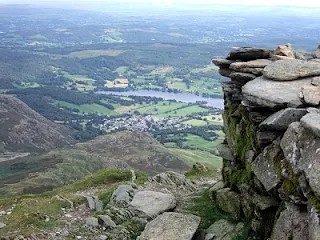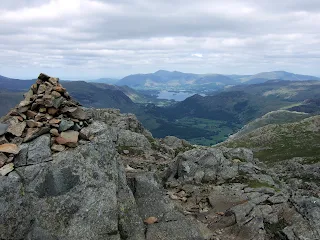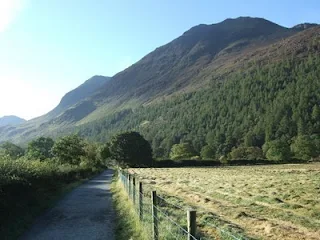
This is a walk along the length of the Coniston Fells in the Furness region of South Lakeland. As described the walk takes in 5 Wainwrights though there are options to extend it to take in all 7 of the Coniston Fells - a long day - or shorten it into a circular route visiting 4 summits. My own chosen variation visits 5 tops including the remote summit of Grey Friar at the northern edge of the range, this being the only fell in the area I hadn't previously climbed.
Setting out along the stony track of the Walna Scar Road - a track closed to traffic - I passed the path turning right up the steep hill to Coniston Old Man - the Boo Tarn route. This is a quiet and pleasant way to that peak that is much to be preferred to the traditional way via Low water and it is described in full on my Coniston old Man page. The way is now signposted by where a quarry road leaves the Walna Scar route. There is more on the traffic free status of that route at the end of this post.
After three quarters of a mile I left the Walna Scar Track to follow a path up to the right leading past the deep blue waters of Goats Water, a mountain tarn beneath the soaring rocks of Dow Crag on its far shore where several rock climbers could be seen ascending the cliffs far above. Now the path climbed steeply over rough terrain to gain the col of Goats Hause which separates Dow Crag from the Old Man. Here groups of walkers rested after the warm steep ascent.
The steady stream of people now headed off to either one of these peaks though my route followed the fainter path that after the initial right turn branched off to the left to contour the slope at an easy angle towards Swirl How with my own objective of Grey Friar seen across the deep valley containing Seathwaite Tarn. This path simply saves climbing up over Brim Fell which marks the main ridge and would be my return route.
With little effort I reached the col before Swirl How and began the ascent again. The views now opened out to Levers Water down the opposite side of the ridge with Coniston Water below and the green expanse of Grizedale Forest beyond. After the false summit of Great How crags was passed I made my way - with the groups of walkers - over to the cairn marking the top of Swirl How. Though overtopped by a matter of a metre or 3 feet by Coniston Old Man, Swirl How is actually the main peak of the Coniston Fells and it is fom here that the ridges connect to each end of the group.
One such ridge falling in just north of an easterly line to connect with Wetherlam is the Prison Band and this is an option for a circular route. If you had ascended by the Boo Tarn - or Low Water for that matter - route to the Old Man and followed the ridge here, descending the Prison Band to Levers Hause and going down to Levers Water gives the choice of returning to the Walna Scar Road via "Boulder Valley" or continuing down to Coniston.
I had a rest and some more water on the top of Swirl How watching the various groups milling their way along the wide ridge - most were going no further than this - when I got chatting to a girl who came and sat on the next rock to my own. Turns out that she'd set off from Langdale that morning and had already climbed Pike o' Blisco and Cold Pike on the far side of the Wrynose road before arriving here via Grey Friar. Her plan was to continue to Dow Crag and the Old Man and return to Langdale via Wetherlam so climbing all of the Coniston Fells. Impressed? I was!
Jaqueline was doing the Wainwrights and had set off that day to see how many summits she could reach - a few more than I would today - but at least I had done most of them already! We compared Munros and Wainwrights for a while before heading off on our separate ways into the hills. What a thoroughly charming girl!
The way from here to the next summit, Great Carrs is simply a matter of a few minutes walk with spectacular views into the Central Lakes. The crowds had gone and as I set off for Grey Friar pretty much everyone had gone. Grey Friar stands in remote mountain country separate from the main Coniston Fells overlooking the beautiful and unspoilt Duddon Valley and the lonely country above Cockley Beck - Upper Eskdale and the Scafell Range which was topped with grey cloud - one of the finest views in the Lakes.
I finished my lunch on the summit in the chill wind that had sprung up before heading back. Another easy path contoured the hillside around to the right from the depression between Grey Friar anf Swirl How so avoiding re-ascending those fells I had just climbed. The path joined the ridge again just before the ascent to Brim Fell which was an easy steady climb past several cairns to the broad expanse of the summit. Despite the increased cloud, the air remained clear and the Isle of Man floated surreally over the top of Harter Fell. Coniston Old Man was only a short way from here and soon I had rejoined the tourists on its summit who milled around taking photos of each other by the trig point.
I strained my eyes looking across the silver expanse of the Irish Sea in search of Snowdon - yes perhaps a dark smudge was just visible on the edge of things. Occasionally one can see as far as the Welsh Mountains from the Lake District but it is not so common. No sign of my companion of earlier - she must already be on her way back by now.
I set off leaving the tourists to do touristy things and headed south towards the top of the Boo Tarn Route. A faint path was soon picked up and I followed it down to the Walna Scar Road. If descending by this route do not stray too far to the right - towards the valley containing Goats Water - the ground is much steeper with crags there. Once the path is found it becomes more obvious the further you go. In mist - which is most of the time at Coniston - it is perhaps better to go down by the normal way past Low Water. Here even the most navigationally challenged would struggle to lose their way. All in all I would rate this as a good day out in the hills.
Pete Buckley August 2010
Summits >>> Swirl How 802m/2632ft >>> Great Carrs 785m/2575ft >>> Grey Friar 773m/2536ft >>> Brim Fell 796m/2611ft >>> Coniston Old Man 803m/2635ft
Essentials >>> 860m/2820ft of climbing and descent >>> 15.4km or 9.6 miles of walking >>> Start and finish at the sart of the Walna Scar Road or from Coniston >>> check out my homepage for more walks and hikes
Postscript: As I reached the car park there were 2 guys from ITV News filming at the start of the Walna Scar road. As it turns out they were covering the story that the road had - that very morning been closed to traffic. I had been under the impression that it was anyway but no - it had been opened and closed at regular intervals and todays news was the latest in the saga. The road goes to the Duddon Valley via a 2000 foot pass and driving over it would almost certainly result the destruction of your car but the issue here was use by 4 wheel drive vehicles and off road motor bikers.
My own view on this matter is clear - the road should remain for use by non motorised transport only with the exception of essential traffic related to the quarry, use by farmers and the mountain rescue service. There is more on this matter in an article I have published here




